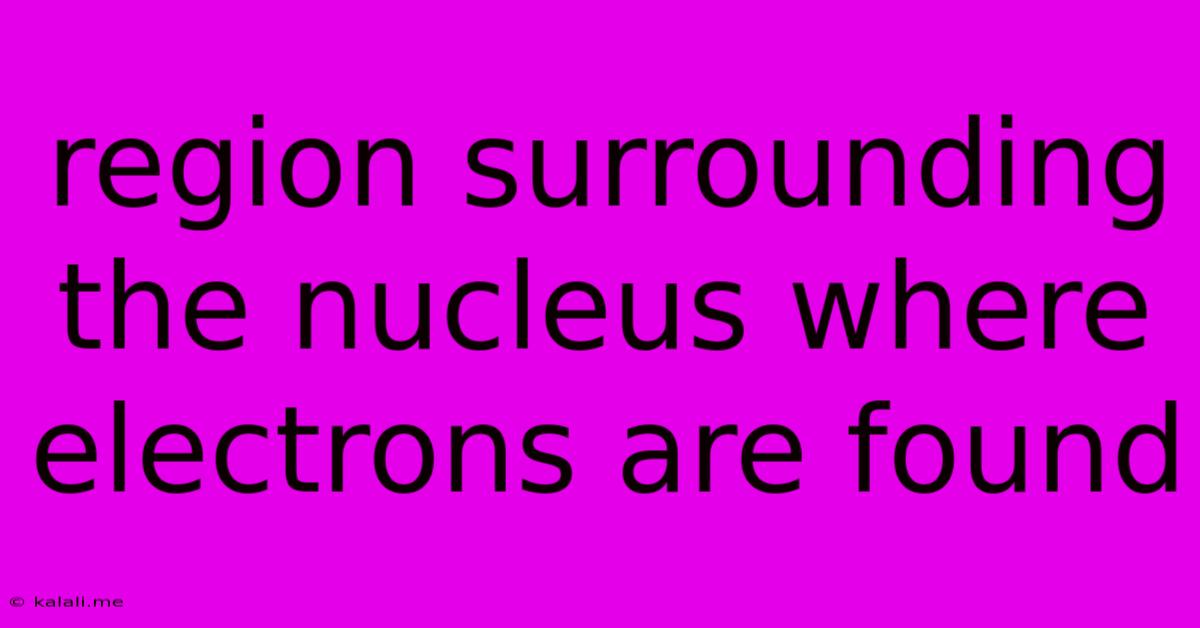Region Surrounding The Nucleus Where Electrons Are Found
Kalali
May 10, 2025 · 3 min read

Table of Contents
Delving into the Electron Cloud: The Region Surrounding the Nucleus
The atom, the fundamental building block of matter, is far more complex than its simple representation as a miniature solar system. While the simplified model depicts electrons orbiting the nucleus like planets around the sun, the reality is significantly more nuanced and fascinating. The region surrounding the nucleus where electrons are found isn't a neatly defined orbit, but rather a probabilistic cloud known as the electron cloud or electron shell. This article explores the intricacies of this region, its significance in atomic structure, and the concepts that govern electron behavior within it.
Understanding the electron cloud is crucial for grasping the fundamental principles of chemistry and physics. Its properties determine an atom's reactivity, its bonding capabilities, and its overall behavior in various chemical reactions and physical processes.
Orbitals: The Probability Maps of Electron Location
Instead of precise orbits, electrons occupy regions of space called atomic orbitals. These orbitals are not physical paths but rather mathematical representations of the probability of finding an electron in a particular location around the nucleus. Think of them as probability density maps, showing where an electron is most likely to be found. The higher the probability density at a given point, the greater the chance of finding an electron there.
Several factors determine the shape and energy of these orbitals:
- Principal Quantum Number (n): This number defines the energy level of the electron and the average distance of the orbital from the nucleus. Higher values of 'n' indicate higher energy levels and greater distances.
- Angular Momentum Quantum Number (l): This determines the shape of the orbital. 'l' values of 0, 1, 2, and 3 correspond to s, p, d, and f orbitals, respectively, each with distinct shapes. S orbitals are spherical, p orbitals are dumbbell-shaped, and d and f orbitals have more complex geometries.
- Magnetic Quantum Number (ml): This specifies the orientation of the orbital in space. For example, p orbitals can be oriented along the x, y, and z axes.
- Spin Quantum Number (ms): This describes the intrinsic angular momentum of the electron, often referred to as "spin." Electrons can have a spin of +1/2 or -1/2.
Electron Shells and Subshells
Atomic orbitals are grouped into electron shells, which represent the principal energy levels. Each shell can contain multiple subshells, corresponding to different values of the angular momentum quantum number (l). For example, the first shell (n=1) contains only one subshell (1s), while the second shell (n=2) contains two subshells (2s and 2p).
The filling of electron shells and subshells follows specific rules, including the Aufbau principle (electrons fill orbitals from lowest to highest energy), the Pauli exclusion principle (each orbital can hold a maximum of two electrons with opposite spins), and Hund's rule (electrons fill orbitals individually before pairing up).
Beyond the Simple Model: Quantum Mechanics and the Electron Cloud
The concept of the electron cloud arises directly from the principles of quantum mechanics. Unlike classical mechanics, which describes the motion of macroscopic objects with certainty, quantum mechanics deals with probabilities. The uncertainty principle, a cornerstone of quantum mechanics, dictates that we cannot simultaneously know both the exact position and momentum of an electron. Therefore, we can only describe the probability of finding an electron in a given region of space, leading to the concept of the electron cloud.
Understanding the electron cloud, its constituent orbitals, and the quantum mechanical principles that govern it provides a crucial foundation for advanced studies in chemistry, physics, and materials science. It helps explain atomic properties, chemical bonding, and the behavior of matter at the atomic level. The probabilistic nature of the electron cloud highlights the limitations of simplified atomic models and underscores the power of quantum mechanics in describing the microscopic world.
Latest Posts
Latest Posts
-
How Long Would It Take To Get To China
Jul 13, 2025
-
How Many 1 8 Teaspoons In A Teaspoon
Jul 13, 2025
-
What Happened To Christopher F Lima And Tim Loock
Jul 13, 2025
-
Gifts That Begin With The Letter M
Jul 13, 2025
-
What Fraction Is Equivalent To 1 2
Jul 13, 2025
Related Post
Thank you for visiting our website which covers about Region Surrounding The Nucleus Where Electrons Are Found . We hope the information provided has been useful to you. Feel free to contact us if you have any questions or need further assistance. See you next time and don't miss to bookmark.